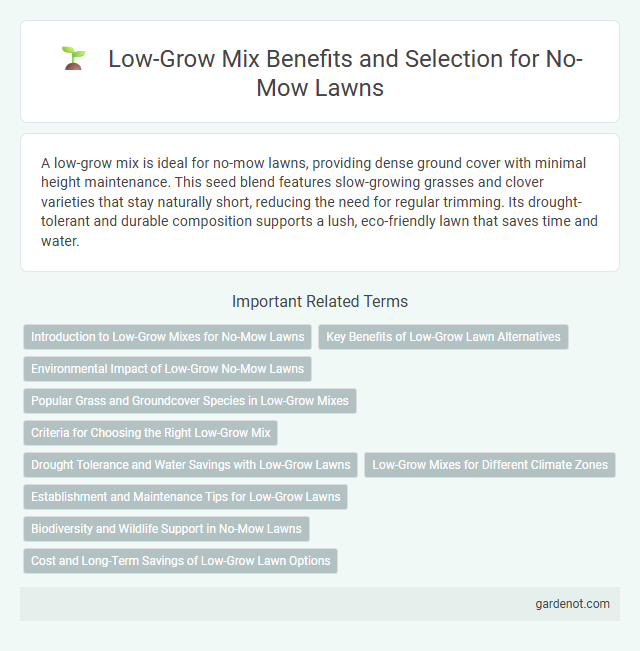A low-grow mix is ideal for no-mow lawns, providing dense ground cover with minimal height maintenance. This seed blend features slow-growing grasses and clover varieties that stay naturally short, reducing the need for regular trimming. Its drought-tolerant and durable composition supports a lush, eco-friendly lawn that saves time and water.
Introduction to Low-Grow Mixes for No-Mow Lawns
Low-grow mixes for no-mow lawns typically include fine fescues and native grasses that remain short and dense, minimizing maintenance requirements. These mixes enhance soil health and biodiversity by supporting beneficial insects and requiring less water and fertilizer than traditional turfgrass. Choosing the right low-grow mix tailored to your regional climate ensures a sustainable, attractive lawn with minimal mowing and environmental impact.
Key Benefits of Low-Grow Lawn Alternatives
Low-grow lawn alternatives, such as fine fescues and creeping thyme, require significantly less water and reduce the need for frequent mowing, lowering overall maintenance costs. These drought-tolerant species improve soil health by enhancing organic matter and encouraging microbial activity. Their dense growth also suppresses weed invasion, promoting a healthier and more resilient lawn ecosystem.
Environmental Impact of Low-Grow No-Mow Lawns
Low-grow no-mow lawn mixes significantly reduce water consumption by requiring minimal irrigation compared to traditional grass lawns, promoting sustainable water management. These lawns enhance biodiversity by providing habitat for pollinators and beneficial insects, contributing to healthier ecosystems. Reduced mowing frequency lowers carbon emissions and noise pollution, making low-grow no-mow lawns an eco-friendly solution for sustainable landscaping.
Popular Grass and Groundcover Species in Low-Grow Mixes
Low-grow mixes commonly include popular grass species like fine fescues (Festuca spp.) and Kentucky bluegrass (Poa pratensis), known for their fine texture and low maintenance. Groundcovers such as creeping thyme (Thymus serpyllum) and clover (Trifolium repens) enhance drought tolerance while suppressing weeds. These species create dense, resilient mats that reduce mowing frequency and promote sustainable lawn care.
Criteria for Choosing the Right Low-Grow Mix
Selecting the ideal low-grow mix for a no-mow lawn hinges on factors such as drought tolerance, shade adaptability, and maintenance requirements. Opt for species with slow vertical growth rates, like fine fescues or native grasses, which minimize the need for frequent mowing. Soil compatibility and regional climate resilience are crucial criteria to ensure a sustainable, low-maintenance turf solution.
Drought Tolerance and Water Savings with Low-Grow Lawns
Low-grow lawn mixes featuring drought-tolerant grass species reduce water consumption significantly by minimizing irrigation needs. These mixes often include fine fescues and buffalo grass, which maintain healthy growth with less moisture, promoting water savings in arid environments. Implementing low-grow lawns contributes to sustainable landscaping by conserving water resources while providing durable, low-maintenance turf.
Low-Grow Mixes for Different Climate Zones
Low-grow mix seed blends are specifically designed to thrive in diverse climate zones, providing drought resistance in arid regions and cold tolerance in northern areas. These mixes often include fine fescues, buffalo grass, and other native species that require minimal mowing while maintaining a dense, green turf. Selecting a regionally adapted low-grow mix optimizes lawn sustainability, reduces water usage, and supports ecosystem health across varying environmental conditions.
Establishment and Maintenance Tips for Low-Grow Lawns
Low-grow lawn mixes, featuring species like fine fescues and dwarf bluegrass, establish quickly with consistent moisture and minimal soil disturbance. Proper maintenance includes mowing at higher blades to encourage dense growth and reduce weed intrusion, while infrequent watering promotes deep root systems. Avoid heavy fertilization to maintain the lawn's natural low-growing habit and decrease the need for frequent mowing.
Biodiversity and Wildlife Support in No-Mow Lawns
Low-grow mix in no-mow lawns enhances biodiversity by providing diverse plant species that support pollinators and beneficial insects. This mix encourages habitat creation for wildlife such as butterflies, bees, and ground-nesting birds, promoting ecosystem balance. Maintaining these low-maintenance lawns reduces mowing disturbances, allowing flora and fauna to thrive naturally.
Cost and Long-Term Savings of Low-Grow Lawn Options
Low-grow lawn mixes significantly reduce maintenance costs by minimizing the need for frequent mowing, watering, and fertilizing. Over time, these savings accumulate, offering homeowners a cost-effective alternative to traditional grass lawns. Investing in low-grow turf varieties also promotes environmental benefits by lowering water consumption and reducing carbon emissions from lawn equipment.
Low-grow mix Infographic

 gardenot.com
gardenot.com